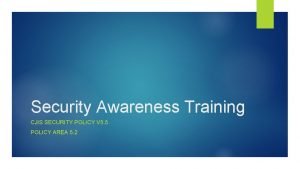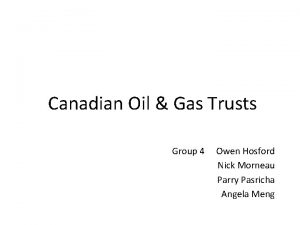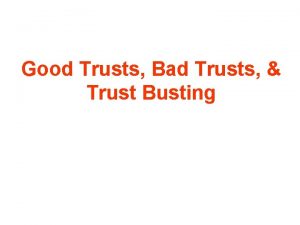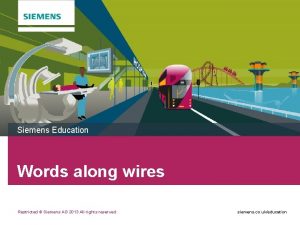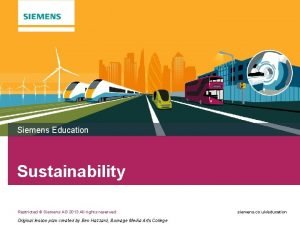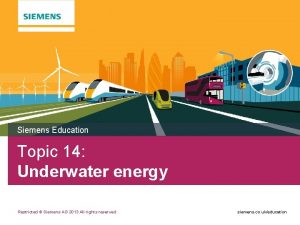Siemens and The Wildlife Trusts Restricted Siemens AG










![Benefits of Wetlands Source: Food and Agriculture Organization of the United Nations, [2016], [FAO Benefits of Wetlands Source: Food and Agriculture Organization of the United Nations, [2016], [FAO](https://slidetodoc.com/presentation_image_h2/ebb9a7ae0f95ddd47bb14ef0497973c0/image-11.jpg)





- Slides: 16

Siemens and The Wildlife Trusts Restricted © Siemens AG 20 XX July 2017 In partnership with

Lesson 2 - Water In partnership with

Learning Objectives • To understand the importance of natural environments and organisations being responsible and collaborating to achieve long term sustainability. • To identify how we use water personally vs how we use water as a resource. • To gain an understanding of the water cycle and how it impacts specific habitats. • To explore the impacts that water turbines have on animals and the surrounding environment. In partnership with

Learning Outcomes • Understand the stages of the water cycle • Understand how the water cycle is affected by climate change • Gain an understanding of how reliant ecosystems are on water • Explore the advantages and disadvantages of using water to generate and decarbonise our energy generation. In partnership with

The Water Cycle The water cycle is the process by which water travels from the Earth's surface to the atmosphere and then back to the ground again. The sun provides the energy to exchange continuous moisture between oceans, land atmosphere. In partnership with

How much do you know about water? Decide whether each of these statements is true or false. • There are fewer than one million lakes and ponds in the world. • Ponds are very important for combating climate change. • Lake Windermere is England’s largest lake. • Reservoirs can affect the Earth’s rotation. https: //www. opalexplorenature. org/water-quiz In partnership with

How much do you know about water? • There are fewer than one million lakes and ponds in the world False: There an estimated 304 million natural lakes and ponds in the world, covering an area of about 4. 2 million km 2 – that's 17 times the size of the UK!! • Ponds are very important for combating climate change? True: They can trap carbon 20 -50 times faster than trees, and together they bury four times as much carbon as the world’s oceans. • Lake Windermere is England’s largest lake? True: Lake Windermere is the largest lake in England, it has a surface area of 14. 7 km 2, a maximum depth of 67 m and its own tide. However, the largest ‘lake’ in Britain is Loch Ness in Scotland which holds more water than all the lakes and rivers in England Wales combined • Reservoirs can affect the Earth’s rotation? True: Over the past 40 years about 10 trillion tonnes of water have been stored in reservoirs, mostly in the northern hemisphere, which has become heavier as a result. This redistribution of mass has quickened the Earth's spin in much the same way an ice skater might bring their arms close to their body in order to spin faster. A faster spin shortens the day and so, due to water storage in reservoirs, the day is now shorter than it was 40 years ago - but only by about eight-millionths of a second, so don't worry too much! In partnership with

Water Cycle and Habitats • All living organisms need water to grow and survive. In an ecosystem, water cycles through the atmosphere, soil, rivers, lakes, and oceans. Some water is stored deep in the earth. Surface water, on the other hand, is the source that sustains life on land. • In many cases, water structures the habitat of an ecosystem. Polar bears, for example, rely on ocean ice in order to successfully hunt and capture seals. What’s more, the majority of life on Earth actually lives completely submerged in the waters of the oceans. In partnership with

How climate change will affect the Water cycle Climate Change Impact on Water Cycle © FAO 2015 - http: //www. fao. org/land-water/en/ Bring in image again and DO NOT STRETCH Climate change will have a drastic affect on the water cycle from the sea to the mountains, use the diagram to explore the different changes that are occurring and consider their impacts. Climate Change Impact on Water Cycle © FAO 2015 - http: //www. fao. org/land-water/en/ Restricted © Siemens AG 20 XX Page 9 YYYY-MM-DD In partnership with Author / Department

Wetlands are among the most productive ecosystems in the world, comparable to rainforests and coral reefs, and have a valuable role in protecting and improving water quality, providing habitats, storing floodwaters and helping reduce the impacts of extreme weather events. https: //www. flickr. com/photos/usfwsnortheast/8070749192/ In partnership with
![Benefits of Wetlands Source Food and Agriculture Organization of the United Nations 2016 FAO Benefits of Wetlands Source: Food and Agriculture Organization of the United Nations, [2016], [FAO](https://slidetodoc.com/presentation_image_h2/ebb9a7ae0f95ddd47bb14ef0497973c0/image-11.jpg)
Benefits of Wetlands Source: Food and Agriculture Organization of the United Nations, [2016], [FAO - HQ], [Climate Change and food security: risks and responses], [http: //www. fao. org/3/a-i 5188 e. pdf]. Reproduced with permission Page 11 YYYY-MM-DD In partnership with Author / Department

Desertification • The amount of water on the planet is finite. Whilst some areas of the world may see increased rainfall and risk of flooding due to global warming, others will become increasingly arid. This can lead to desertification which is when land that was a different biome, like Savannah, degrades into a desert. • There are many reasons why this occurs such as deforestation and over grazing, but the effects of prolonged droughts caused by changing weather patterns are exacerbating desertification. This process is extremely damaging to both the natural and human population of a region, increasing risk of famine, wildfires and species loss. Biomes are distinct biological communities that form in response to a shared physical climate. A biome can comprise a variety of habitats. In partnership with

How can technology help? Water Turbines and Hydroelectricity Hydro electric plants help produce renewable energy that does not release Carbon Dioxide. However, most hydroelectric power plants use a dam and a reservoir, obstructing fish migration and affecting their populations. Operating one can affect water temperature and the river's natural flow. These changes may harm plants and animals both in the river and on land. http: //www. elanvalley. org. uk/discover/reservoirs-dams/6 -dams - Elan Valley Trust In partnership with

Problems caused by dams Nature Reservoir water is usually slow moving. As a result, the reservoir will have excess amounts of sediments and nutrients, which can lead to a surplus of algae and other weeds. These weeds can take over other forms of animal and plant-life in the river. This can be controlled by manual harvesting or by introducing fish that eat these plants. Although there are many methods to minimize the impact of injuries to animals, including fish ladders and intake screens, fish and other organisms can be injured and potentially killed by turbine blades People Reservoirs may cover people's homes, important natural areas, agricultural land, and archaeological sites. Thus, building dams can require relocating people. Methane, a strong greenhouse gas, may also form in some reservoirs and be emitted to the atmosphere. Carlos Delgado; CC-BY-SA In partnership with

Solutions to protect wildlife • If too much water is stored behind the reservoir, segments of the river downstream can dry out. Most hydroelectric operators are required to release a minimum amount of water at certain times of year. If not, water levels downstream will drop, endangering animal and plant life. • In addition, reservoir water is typically low in dissolved oxygen and colder than normal river water. When this water is released, it could have negative impacts on downstream plants and animals. • To mitigate these impacts, aerating turbines can be installed to increase dissolved oxygen and multi-level water intakes can help ensure that water released comes from all levels of the reservoir, rather than just the bottom (which is the coldest and has the lowest dissolved oxygen). In partnership with

SIEMENS SMART water turbine for running rivers • SMART hydrokinetic turbines only use the river's water flow energy to generate electricity. This can be used over and over again, so you can connect multiple turbines in one to make the most out of the power in a simple way. The turbine is powered by kinetic energy so no dams are necessary to operate the device. • Additionally, the river shape is unchanged and no infrastructural investments are required. The product is cost effective meaning it is perfect for both industrialised countries and emerging countries. The system doesn’t require any maintenance and only needs regular cleaning. • The impact is that, with energy available in rural areas, productivity per population increases which means partnerships can be made with local and national economies. The impact of this can be seen using ‘Water is Life’ resources. In partnership with
 Cjis security levels
Cjis security levels Cjis meaning
Cjis meaning Industrialists of the late 1800s used pools and trusts to
Industrialists of the late 1800s used pools and trusts to Industrialists of the late 1800s used pools and trusts to
Industrialists of the late 1800s used pools and trusts to History of equity and trusts
History of equity and trusts Charitable purpose trust problem question
Charitable purpose trust problem question Canadian oil and gas trusts
Canadian oil and gas trusts What steps did roosevelt take to solve trusts
What steps did roosevelt take to solve trusts Why are the trusts portrayed as vultures
Why are the trusts portrayed as vultures Content filtering trusts
Content filtering trusts Special needs trusts colorado
Special needs trusts colorado Extc
Extc Purpose trust definition
Purpose trust definition Development trusts ni
Development trusts ni 53 trusts
53 trusts California land trusts
California land trusts What is a trust fund
What is a trust fund

